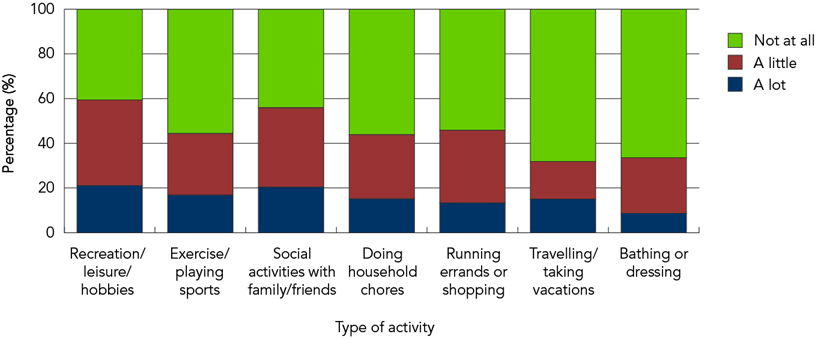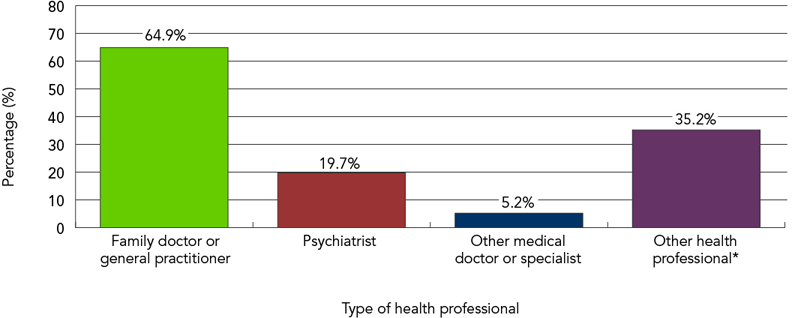Mood and anxiety disorders in Canada
Fast facts from the 2014 Survey on Living with Chronic Diseases in Canada
Summary
- In 2013, an estimated 3 million Canadians (11.6%) aged 18 years or older reported that they had a mood and/or anxiety disorder.
- More than a quarter (27%) reported that their disorder(s) affected their life "quite a bit" or "extremely" in the previous 12 months. Basic activities and the ability to work are challenging for many.
- While the majority consulted a health professional about their disorder(s) in the previous 12 months, almost a quarter (23%) did not.
- Most people with mood and/or anxiety disorder(s) are currently taking, or have taken, prescription medication(s) (93%), but few (20%) have received psychological counselling to help manage their disorder(s).
- Becoming more informed about their disorder(s) and adopting good sleep habits are common coping strategies; however, engaging in other self-management strategies such as physical activity/exercise, meditative practices and developing a care plan are less common.
Introduction
Mood and anxiety disorders are among the most common types of mental disorders in Canada and have been shown to have a major impact on the daily lives of those affected. In 2013, an estimated 3 million Canadians (11.6%) aged 18 years or older reported that they had a mood and/or anxiety disorder.Footnote 1

Alternative Formats
Mood disorders are characterized by the lowering or elevation of a person's mood, while anxiety disorders are characterized by excessive and persistent feelings of nervousness, anxiety, and even fear. Both types of disorders interfere with an individual's everyday life for an extended period of time.Footnote 2 Professional care combined with active engagement in self-management strategies can foster recovery and improve the well-being of people affected by these disorders, ultimately enabling them to lead full and active lives.Footnote 3
Mood and anxiety disorders have a major impact on people's lives
Basic activities that most people are able to do are challenging for people with mood and anxiety disorders
- Of people with mood and/or anxiety disorders, 27% reported that their disorder(s) have affected their life "quite a bit" or "extremely" in the past 12 months.
- The degree to which their disorder(s) limited their activities varied by type: activities such as recreation, leisure or hobbies were the most limited, followed by social activities with family and friends (Figure 1).
Figure 1: Level of difficulty experienced with basic activities by type of activity among those with mood and/or anxiety disorder(s), 18 years and older, Canada (excluding territories), 2013

Text description of Figure 1
The percentage of those with mood and/or anxiety disorder(s) who reported being limited "a lot", "a little" or "not at all" as a result of their disorder(s) by type of activity in the past 12 months is presented in Figure 1 and in the table below.
The degree to which individuals' disorder(s) limited their activities varied by type of activity. Activities such as recreation, leisure or hobbies were the most limited, followed by social activities with family and friends.
| Type of activity | Level of difficulty | ||
|---|---|---|---|
| A lot (%) | A little (%) | Not at all (%) | |
| Recreation/leisure/hobbies | 21.1 | 38.3 | 40.5 |
| Eexercise/playing sports | 16.8 | 27.6 | 55.5 |
| Social activities with family/friends | 20.4 | 35.5 | 44.0 |
| Doing household chores | 15.2 | 28.7 | 56.1 |
| Running errands or shopping | 13.3 | 32.5 | 54.2 |
| Travelling/taking vacations | 15.1 | 16.8 | 68.1 |
| Bathing or dressing | 8.7 | 24.8 | 66.5 |
Mood and anxiety disorders also affect people's ability to work
Of those who are currently working or have worked since being diagnosed:
- 50% reported requiring some kind of job modification to continue working (i.e. change in the number of hours worked, type of work, or how work tasks are carried out) because of their mood and/or anxiety disorder(s); and
- 35% reported having ever stopped working altogether because of their mood and/or anxiety disorder(s).
Managing mood and anxiety disorders
Ensuring individuals with mood and/or anxiety disorders are receiving the professional care they need and making the necessary lifestyle changes can foster recovery and optimize their mental health and well being.
Professional care is essential in the management of mood and anxiety disorders
In the past 12 months,
- 77% reported having seen or talked to a health professional about their mood and/or anxiety disorder(s), with family doctors or general practitioners being the most commonly consulted (Figure 2); and
- Almost one-quarter of respondents (23%) reported that they did not consult any health professionals about their disorder(s).
Figure 2: Percentage of those with mood and/or anxiety disorder(s), 18 years and older, who consulted a health professional (by type) about their disorder(s) in the past 12 months, Canada (excluding territories), 2013

*Psychologist, social worker, counsellor, psychotherapist or other health professional.
Percentages do not add to 100% because an individual can visit more than one type of health professional in a 12 month period.
Text description of Figure 2
The percentage of those with mood and/or anxiety disorder(s) who consulted a health professional about their disorder(s) by type of professional in the past 12 months is presented in Figure 2 and the table below.
Family doctors or general practitioners were the most commonly consulted health professionals.
| Type of health care professional | Consulted (%) |
|---|---|
Percentages do not add to 100% because an individual can visit more than one type of health professional in a 12 month period. |
|
| Family doctor or general practitioner | 64.9 |
| Psychiatrist | 19.7 |
| Other medical doctor or specialist | 5.2 |
| Other health professionalFootnote * | 35.2 |
Medication and counselling are first-line treatments in the management of mood and anxiety disorders
When asked about the management of their mood and/or anxiety disorders,
- 95% of respondents reported that a doctor or other health professional had suggested taking prescription medication(s);
- 70% stated that they are currently taking prescription medication(s) for their mood and/or anxiety disorder(s) and of those who stated they were not, 77% reported they had done so previously. Overall, 7% stated having never (currently nor previously) taken prescription medication(s) for their disorder(s);
- 62% reported that a doctor or other health professional had suggested getting psychological counselling to help manage their mood and/or anxiety disorder(s); and
- 20% stated that they received psychological counselling to help manage their disorder(s) in the past 12 months.
Self-management of mood and anxiety disorders
Providing Canadians with the information and tools needed to effectively manage mood and/or anxiety disorder(s) will foster recovery and help people living with these disorders achieve their full potential.
To help manage their disorder(s),
- Two in three respondents (64%) reported that they exercised or participated in physical activity, and the majority of these individuals (98%) stated that they continue to do so at least two to three times a week;
- 71% reported that they adopted good sleep habits,Footnote 4 and 93% reported they still continue to do so;
- Less than a third (28%) reported that they have developed a care or a crisis plan;Footnote 5
- 43% reported that they have engaged in reflective or meditative practices;
- 83% said that they have educated themselves about their disorder(s); and
- 14% of respondents with a mood disorder reported that they have used light therapy to manage their disorder.
Data source
Estimates were calculated using the 2014 Survey on Living with Chronic Diseases in Canada (SLCDC) which was funded and developed by the Public Health Agency of Canada (the Agency), and conducted by Statistics Canada. The 2014 SLCDC, a cross-sectional follow-up to the 2013 Canadian Community Health Survey, provides information on how mood and anxiety disorders impact Canadians and how individuals affected and their health professional(s) manage them. The survey interviewed a nationally representative sample of 3,361 Canadians from the ten provinces aged 18 years and older with self-reported mood and/or anxiety disorder(s) diagnosed by a health professional.
The Agency monitors and reports on mental illnesses in Canada. For more information consult the Agency's Mental Illness page.
The data presented in this fact sheet can be accessed via the Agency's Chronic Disease Infobase Data Cubes. Data cubes are interactive databases that allow users to create tables and graphs quickly using their Web browser. Should you plan to use this data for publication purposes, please email the Agency at infobase@phac-aspc.gc.ca.